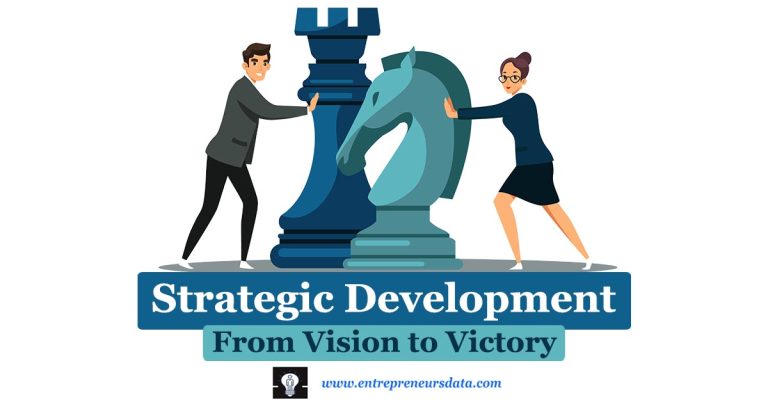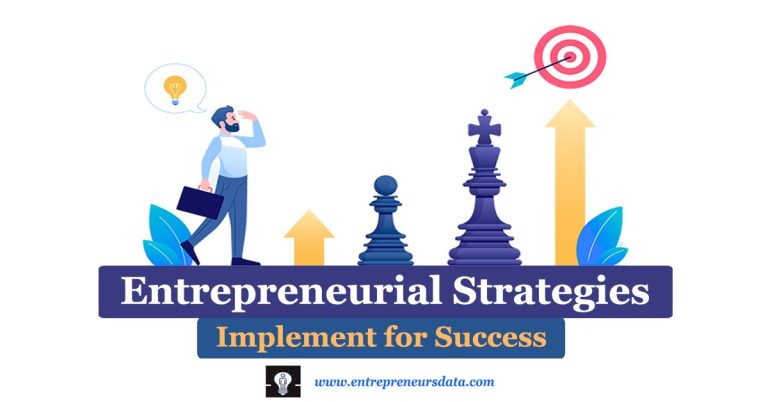Strategic Entrepreneurship: Meaning, Characteristics & Examples – The foundation of entrepreneurial success in organizations is the relationship between strategy and entrepreneurship, or strategic entrepreneurship. At that intersection of strategy and entrepreneurship, strategic entrepreneurship (SE) has become a significant field of entrepreneurship during the past 20 years.
Through this article, we are discussing;
Strategic Entrepreneurship Meaning
Strategic entrepreneurship meaning – Entrepreneurship is the process of identifying and taking advantage of untapped possibilities in the external environment. By doing so, businesses and industries can develop long-term competitive advantages.
Although entrepreneurship is an element that can add organizational dynamism by bringing new techniques and creating comparative advantages, it cannot achieve notable success without a unique strategy. Therefore, strategic entrepreneurship will be necessary for the synergistic and efficient application of the benefits of both. To develop and attain superior performance and carry out planned actions to create money, strategic entrepreneurship combines entrepreneurial activities with strategic perspectives.
The combination of the disciplines of strategic management and entrepreneurship, or the identification of possibilities through innovation, is known as strategic entrepreneurship. Therefore, we can characterize strategic entrepreneurship as an organization’s attempts to capitalize on its competitive advantages now while examining the innovations that will serve as the cornerstone of its advantages tomorrow.
The entrepreneurial aspect of strategic entrepreneurship focuses on finding opportunities to take advantage of through innovation, while the strategic aspect considers the best method to manage the firm’s innovation initiatives. A company may pursue strategic entrepreneurship for a variety of objectives, such as boosting organizational profitability, strengthening its position in the market, or revitalizing existing firms. Corporate entrepreneurs are people who take risks within large, established enterprises. The idea of using innovation and entrepreneurship within well-established corporations is known as corporate entrepreneurship.
SE refers to an organization’s ongoing preparedness to investigate new competitive domains and discover the capabilities required to exploit them. The primary contribution of the field of SE in organizations is to raise awareness and knowledge of the role of entrepreneurship in interconnected organizations, revitalize these organizations and improve organizational performance.
The ideas of strategy, entrepreneurship, corporate entrepreneurship, and entrepreneurial strategies are all related but separate from the idea of strategic entrepreneurship. Strategic entrepreneurship is a distinct type of strategy in which a company understands that sustained competitive advantage depends on a company’s capacity to create a stream of ongoing innovation to stay ahead of rivals rather than on any one source of competency. The operations, culture, and other organizational issues of strategic entrepreneurship are very different from those faced by businesses that rely on a single source of competitive advantage since the firm must constantly innovate.
The use of or development of entrepreneurial activity to realize strategic goals is known as strategic entrepreneurship. Strategic entrepreneurship aims to integrate entrepreneurship with strategic management through entrepreneurial action from a strategic perspective. The use of opportunities and change adaptation are the main concerns in the disciplines of entrepreneurship and strategic management. As a result, one of the key points of overlap between entrepreneurship and strategy management is opportunities. The idea of entrepreneurship and strategic management both prioritize opportunities. In addition to being a unique form of creative destruction, strategic entrepreneurship in large organizations is essentially organizational entrepreneurship with a strategic objective.
We concentrate on three aspects, drawing on current research in strategic entrepreneurship. These three components include;
1. Fostering a proper mindset within the business.
2. Achieving stability between exploration and exploitation
3. Constant invention.
Creating a mindset within the company that can balance short- and long-term goals is one of the most difficult aspects of engaging in strategic entrepreneurship.
We concentrate on the second aspect of strategic entrepreneurship: striking a balance between exploration and exploitation. Exploration is a process that comprises experimentation, search, innovation, integration of various knowledge sources, and variation.
Continuous innovation, the third essential component, is the main mechanism by which strategic entrepreneurship positively affects a company’s capacity to generate wealth. In an ideal world, the entrepreneurship outlined above would produce a consistent stream of both incrementally and radically novel ideas, from which the firm’s strategy would extract value. Continuous innovation is built on a balance between the research of new areas and the exploitation of existing domains in light of the altering competitive landscape.
The primary difference between (corporate) entrepreneurship and strategic entrepreneurship is that the former focuses on the identification and exploitation of particular opportunities, whereas the latter is structured so that the company can benefit from a steady stream of entrepreneurial opportunities over protracted periods.
Small businesses seem to benefit most from strategic entrepreneurship. In any case, small businesses face various obstacles to success and growth. Consequently, managing the long-term development of small businesses in a rapidly changing market remains a relevant task. The majority of small enterprises struggle to manage their long-term growth, and in this circumstance, strategic entrepreneurship can be useful.
One thing connects all types of strategic entrepreneurship: they all require showcasing organizationally significant ideas that are implemented in the quest for competitive advantage.
Strategic Entrepreneurship Characteristics
Identify and Capitalize on Opportunities
The capacity to recognize and take chances is one of the most essential traits of strategic entrepreneurship. Strategic entrepreneurship improves business success by combining opportunity and advantage-seeking behaviors. Successful entrepreneurs are adept at seeing unmet requirements or market gaps and coming up with creative ways to close them. They are continuously looking out for emerging patterns and modifications that can create fresh chances.
Small, entrepreneurial businesses are quite good at seeing possibilities, but they have less success creating the competitive advantages required to capitalize on those chances. Large, well-established companies, on the other hand, frequently create competitive advantages more effectively but are less able to spot fresh chances.
Helps to Maximize the Organization’s Wealth
We suggest that SE is a special, separate concept that businesses can use to generate profit. Important aspects of SE include having an entrepreneurial attitude, having an entrepreneurial culture, having entrepreneurial leadership, managing resources strategically, and using creativity to create innovations.
Entrepreneurial actions with a strategic view improve corporate performance and create a durable competitive advantage. Thus, for firms to make the most profit, strategic entrepreneurship is essential.
Knowledge Sharing Orientation
By increasing the organization’s capacities, strategic entrepreneurship can foster shared organizational knowledge and ongoing innovation. The route of entrepreneurship involves constant learning and development. Successful entrepreneurs are continually looking for methods to increase their knowledge and skills. They do not hesitate to ask mentors and other authorities in their profession for advice and direction.
Effective Resource Utilization
Another crucial aspect of strategic entrepreneurship is the effective utilization of resources. Making the most of your limited time, money, and talent is crucial if you want to succeed as an entrepreneur.
It makes no difference that there are few resources. Organizations can use strategic alliances to pool resources and employ them as efficiently as possible. Successful entrepreneurs have a talent for distributing resources effectively and efficiently to accomplish their objectives.
Innovation Focus
The core of strategic entrepreneurship is innovation. Entrepreneurs are renowned for their talent for developing original and imaginative solutions to problems. They aren’t hesitant to question accepted thinking and think creatively to produce something fresh and worthwhile. New inventions occasionally require the execution of new methods to succeed in the market.
Proactiveness and Persistence
An important aspect of strategic entrepreneurship is proactiveness. Successful entrepreneurs are proactive in spotting opportunities and working to take advantage of them. They go out and create opportunities rather than waiting for them to come to them.
The capacity to persevere in the face of obstacles and failures is persistence. Starting a business is challenging, and successful businesspeople are resilient and determined enough to keep going even when things are difficult.
Risk-Taking and Strategic Focus
Another characteristic of strategic entrepreneurship is risk-taking. Inherently risky, starting a firm, effective entrepreneurs are not afraid to take calculated risks. To accomplish their objectives, they are prepared to venture outside of their comfort zone and take risks.
Strategic focus is the capacity to maintain attention on both the broad picture and the specifics. Successful entrepreneurs have a clear idea of what they want to accomplish and a plan of action to get there. To accomplish their objectives, they can prioritize their operations while remaining flexible and adaptable as necessary.
Strategic Entrepreneurship Examples
Strategic entrepreneurship is more than simply a conceptual topic. Numerous prosperous businesses have used it in their operations. Here are a few examples of enterprises that have used strategic entrepreneurship to expand their operations.
Apple Inc.
One organization that has used strategic entrepreneurship to get to one of the most valued positions in the world is Apple Inc. Co-founder of Apple Steve Jobs was a pro at strategic entrepreneurship. He focused on creating unique products that people would not have known they needed until they saw them. The success of Apple can be attributed in large part to its capacity for continuous innovation, which allowed it to develop products like the iPod, iPhone, and iPad.
A long-term strategic goal for Apple has always been to develop devices that seamlessly blend hardware, software, and services. The company designs goods that are not only useful but also aesthetically pleasing and simple to use. Apple has a devoted following of customers who are willing to spend extra on its products because of its commitment to design and user experience. The success of the company’s iPod, iPhone, and iPad models serve as proof of its ability to innovate and create products that fundamentally transform whole markets.
Amazon Company
Amazon is another best example of strategic entrepreneurship there is. Midway through the 1990s, the business began as an online bookstore. But the company’s creator Jeff Bezos had bigger plans. Bezos recognized the potential of the Internet and saw a chance to upend the retail sector.
Bezos did not stop at just online book sales. He desired to create a comprehensive e-commerce platform that could sell everything. He also understood the value of the customer experience and made it his mission to build the world’s most customer-focused business.
As part of its long-term strategy, Amazon has invested significantly in technology, shipping, and distribution. The company set up a wide network of warehouses and fulfillment centers to enable speedy and efficient delivery. To keep ahead of the curve, they also created their proprietary technology, like the Amazon Echo and Alexa.
The success of Amazon is proof of the effectiveness of strategic entrepreneurship. One of the most valuable corporations in the world, Amazon has grown via relentless innovation and long-term planning.
Tesla Company
Strategic entrepreneurship has been used by Tesla to upend the automobile sector. The company was started in 2003 to accelerate the switch to renewable energy around the world. Tesla’s long-term plan focuses on the development of electric automobiles and renewable energy sources to reduce dependence on fossil fuels. Tesla has built up a devoted customer base that is willing to pay more for its products as a result of its strategic entrepreneurship.
The way Tesla approaches innovation is special. Tesla is upending the automotive business by developing completely new goods rather than adhering to the conventional strategy of making little changes to already existing vehicles. The business’s solar goods are revolutionizing the energy sector, and its electric cars have established new benchmarks for performance and safety.
Customers who are passionate about minimizing their carbon footprint have developed into devoted Tesla supporters as a result of the company’s emphasis on sustainability. The corporation must continue to innovate and lead the way in sustainable energy, according to its long-term objective.
Netflix Platform
Another business that has used strategic entrepreneurship to upend the entertainment sector is Netflix. Before converting to a streaming service, the company offered DVD rentals. Due to its ability to create original material, it has grown to become one of the most well-known streaming services in the world. Netflix has developed a sustainable economic model independent of studio licensing deals because of its strategic entrepreneurship.
Warby Parker
By producing reasonably priced, fashionable eyewear that is sold online, Warby Parker has revolutionized the eyewear market. The business has developed a direct-to-consumer business strategy that eliminates the intermediary thanks to its strategic entrepreneurship. By selling glasses for a fraction of what regular stores charge, the firm has disrupted the conventional eyewear market.
Uber Business Model
Another business that has used strategic entrepreneurship is Uber. With its cutting-edge business strategy, the industry-disrupting ride-sharing giant upended the taxi market. The business developed a platform that links drivers and riders in real-time by utilizing technology. Since the business model was so successful, other businesses like Lyft and Grab have adopted it.
Conclusion
Strategy is an important aspect of entrepreneurship. It finds out the best opportunities for entrepreneurs to take advantage of. Whether your business is small or large strategic entrepreneurship is needed to win the competition. Through this article, we discussed those things.
Identifying and capitalizing on opportunities, helping to maximize the organization’s wealth, knowledge-sharing orientation, effective resource utilization, innovation focus, proactiveness, persistence, risk-taking, and strategic focus are characteristics that we discussed in strategic entrepreneurship.
Lastly, we discussed examples of strategic entrepreneurship. Apple Inc., Amazon Company, Tesla Company, Netflix platform, and Uber business model; used strategic entrepreneurship well to grow their business. Hope you have taken a better knowledge of strategic entrepreneurship through this article. Plz, drop your views in our comment section.







